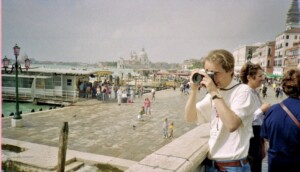The Greatest Movies Never Made Paul Mason

Share this
In 1975, just as the American New Wave was about to peak and break, the novelist Thomas Pynchon suspended a life-long refusal to allow screen adaptations of his work and gave the go-ahead for Sidney Lumet to shoot Gravity's Rainbow.
Lumet had just finished making Dog Day Afternoon and had been reading Pynchon’s thousand-page masterpiece while on the set.
The book is about the war, and Lumet had been in the war. The book is written like a screenplay, albeit one produced in defiance of the five-act structure, and with so many flashbacks, sub-plots and indeed so much sex that, even for the 1970s, it was thought unfilmable.
But Lumet rose to the challenge. He cast Robert Redford as Slothrop, the protagonist, a US intelligence officer who – because of childhood involvement in a Pavlovian experimentation – finds himself sexually aroused by the impact of V2 rockets on London, only (Pavlovians will get this) in advance of their being fired.
He cast a then-unknown Sigourney Weaver to play Katje, a Dutch resistance fighter and karate-kicking femme fatale deployed by Allied intelligence to manipulate Slothrop, and – with the story set in London, France and Nazi Germany – the entire living phalanx of British and European character actors, with Peter O’Toole as Katje’s gritty mentor figure, Pirate Prentice.
This being the era of long films – think Heaven’s Gate, The Godfather Part II – Lumet figured he could go to three hours 40 minutes with an intermission and in any case realised that, once you cut the genealogies and biographical flashbacks, the plot itself is remarkably terse, and close to the classic story arc.
Slothrop in London under the falling V-bombs; Slothrop in the Riviera, in love with Katje but determined to escape from his intelligence handlers; Slothrop amid the chaos of post-war Germany, in a variety of disguises; Slothrop in a Buster Keaton-style railway chase through the V2 factory, evading the psychotic Major Marvy (played by Nick Nolte). Finally – and this is what then positions the work firmly within the American New Wave genre – Slothrop vanishing as a person, with only his spirit alive in the 1970s amid a surreal caravan of harmonica players on the Santa Monica freeway, with ‘quilted steel catering trucks crisscross in the afternoon. Their ripples shine like a lake of potable water after hard desert passage. . .’.
The shoot goes well. Lumet only does realism, so nine-tenths of the novel’s surrealism is cut at the writing stage and – controversial for Pynchon fans – all the songs. Even the ones that could have worked diegetically – like the opener where Prentice and his wartime buddies jerk off to the tune of ‘Have a Banana’ – are cut on principle by Warner Bros.
The movie, once in the can, reads more like Bullitt than, say, Dog Day Afternoon, and has that same misty, Bay Area sunshine glow about it. But it’s disconcerting.
Gravity’s Rainbow is seen by some, me included, as the greatest twentieth-century novel – with perhaps only one equal (see below). But in Pynchon’s narrative Slothrop is not just an anti-hero (being overweight, messy and lazy) but only vaguely there. Though the action happens to him, and triggers emotions and decisions, even by page 1,001 we know the subsidiary characters better than the main one.
However, you cannot achieve this effect on celluloid. Not with Redford’s shimmering eyes and wan smile, and O’Toole’s blue lamps glaring back at him. Redford, in the movie version, becomes the 1940s Everyman; fighting the war as it really was fought – dirtily; seeing all the things that made your dad come back ‘not wanting to talk about it’.
And while Lumet’s style favoured bleak interiors – the newsroom in Network, the strip-lit bank in Dog Day – once in the edit they found the scenes that worked best were the ones they’d spent money on: Slothrop’s fight with a killer octopus on the beach at Cannes, clad in a garish Hawaiian shirt; the chase through the V2 factory; his encounter with an ageing German actress from the silent era on the abandoned UFA sound stage in Potsdam. . .
It bombed, of course, just like Heaven’s Gate. As one critic put it at the time: ‘Somewhere on a beach in California, in a mansion paid for by Warner Bros, Thomas Pynchon is having the last laugh: his novel is unfilmable; the real movie is the book itself.’
***
With the death of Brezhnev in 1982, and the sudden onset of glasnost, Soviet cinema entered a late, unheralded Golden Autumn, offering opportunities to directors who had been dead to the system until Mikhail Gorbachev came to power, and who might have emigrated to the West had the big thaw come, say, eight years later.
One was Aleksandr Askoldov who had been banned from the Soviet cinema after producing a single, iconic movie: Commissar (1967), a bleak, funny realist drama about a Jewish family in the Russian Civil War, based on a short story by the also-banned war journalist Vasily Grossmann.
Newly rehabilitated, Askoldov seized on Grossmann’s recently rediscovered novel Life and Fate – which had survived only on a microfilm smuggled out of the USSR in 1974.
The novel, which is a searing critique of both Stalinism and Nazism, and a powerful condemnation of the experience of anti-Semitism on both sides, was pronounced ‘unpublishable for two hundred years’ by Russian censors. It tells the parallel stories of the battle of Stalingrad and the Holocaust on the same epic scale as Tolstoy’s War and Peace.
Naturally, Askoldov turned to the great Soviet cinematographer Sergei Bondarchuk, who had filmed War and Peace as a four-part movie series in the Sixties, both for inspiration and advice. Given the scale of the project, and the potential international audience, Russian film chiefs determined that the movie would be made in English, with a largely Anglo-Italian cast. Bondarchuk would focus on the battle scenes while Askoldov wove together the intricate personal stories of purges, betrayals and redemptions set across several families and cities.
With Anthony Hopkins as Viktor Shtrum, the scientist purged and then revived by a personal phone call from Stalin, Vanessa Redgrave as the female lead, Zhenya, and Carlo Neri as her lover, the tank commander Novikov, the interpersonal drama reprises Askoldov’s early realist style. Liberated by the decision to shoot in anamorphic widescreen, Askoldov’s scenes depicting family crisis, interrogation and despair take on an epic quality.
Grossmann, a war veteran, had written: ‘There was something terrible, but also something sad and melancholy in this long cry uttered by the Russian infantry as they staged an attack. As it crossed the cold water, it lost its fervour. Instead of valour or gallantry, you could hear the sadness of a soul parting with everything that it loved. . .’.
That single paragraph in Grossman’s story takes seven minutes to tell in the movie; each image becomes a long beat of the action, taking the movie audience from the snow-strewn battlefield to a general’s bunker by the Volga, to the rooftops and minarets of Kazan, to the bedroom of a grieving family.
But Life and Fate ultimately owes its reputation as a movie to its ground-breaking depiction of the Holocaust. Though TV audiences in both Germany and the USA were still reeling from the impact of the miniseries Holocaust (1978), there had been no epic-scale depiction of the Nazi genocide on celluloid, and Claude Lanzmann’s Shoah documentary series was still five years away.
In the novel the narrative follows a Jewish army doctor, Sofya Levinton, into the gas chamber, and to the bitter moment of death. In the movie this scene is faithfully and realistically staged. Though numerous national censors tried to cut the scene, it remains the centrepiece of the authorised version of the film and has been acclaimed for its worldwide contribution to understanding of the genocide.
Askoldov, who remained a bitter critic of Soviet-era anti-Semitism, turned the tables on the censors and threw open the entire history of the USSR to public discussion. Many identify the release of Life and Fate in 1981 as the turning point of modern Russian history, preventing the resurgence of anti-Semitism and great Russian chauvinism that many feared, and speeding up Western re-engagement with the details of, and culpability in, history’s greatest crime.
Askoldov’s Life and Fate, together with the novel that inspired it, are rightly hailed as masterpieces of twentieth-century art.
***
This being the age of fake news, I am obliged to point out that neither Gravity’s Rainbow nor Life and Fate were ever made for cinema. The former was finally turned into a German radio play last year, with Pynchon’s approval. The latter became a highly affective Russian TV series in 2012, though with much of the anti-Stalinist and Holocaust sub-plots eviscerated.
As we enter the age of Netflix, maybe these stories will be told on screen, at a length and depth commensurate with their iconic literary status. If so, I hope their directors will draw inspiration from those who came before.
Askoldov was never again allowed to make a full-length movie, though Commissar was finally released in 1988, to win a Silver Bear. Lumet, as we know, did fine.
Paul Mason is a journalist, film-maker and writer living in London. His latest book How to Stop Fascism: History, Ideology, Resistance is published by Allen Lane.



